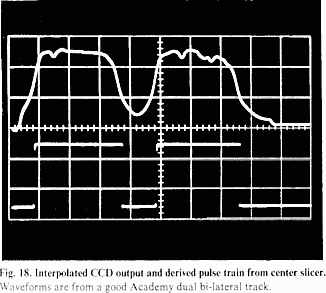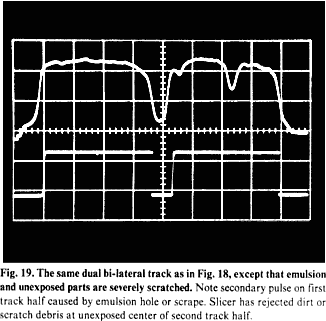  |
Dual bilateral modulation reduces harmonic distortion from non-uniform aperture illumination, or from uneven cell sensitivity across the aperture. The CCD edge reader has much lower dependence upon this factor. Hence, unilateral recording and its edge reading causes little if any increase in low-order crossmodulation or compression distortion, when compared to the level shift of a bilateral or dual bilateral recording.
When a scaled reference image is used to set the slicing density level, small amounts of crossmodulation are reduced several times, compared to average-area reading. This improvement partly occurs due to the fact that duplicate slippage and out-of-focus grains in the short-wave cusps have lower average densities than the higher-density slicing level needed to maintain the correct image scale. Increased modulation noise can result from isolated cusp grains passing through the transition curve, allowing pulse crowding at high modulation. Slight peak noise and clipping may occur on voice sibilance, but this is much less objectionable than uncompensated crossmodulation. This distortion compensation is ideally suited to the Colortek compander system, because un-compensated level shift components from exposure error could occur at sufficient intensity to increase the reproduction gain expansion above the value that is properly needed for the initiating transient. Part of the level shift would be expanded together with the signal, causing sibilant distortion and level pumping. These problems are greatly reduced by optimizing the slicing level and by using compressed tracks of low modulation, which are adequate for expanded wide dynamic range reproduction.
Low-Frequency Reproduction.
An inherent disadvantage of single edge boundary reading is low-frequency noise caused by mechanical sideways film jitter. Sound drum mass and bearing preload resonances, as well as mistracking of the film, caused by jumping from non-parallel rollers are also contributing factors. Most of the resultant noise is cancelled by using the position reference track as the time base for decoding the signal pulse train. This technique works well for normal reproduction of frequencies between 50 Hz and 12 kHz. However, wide-range high-fidelity requirements demand much higher peak energy at both ends of the system response spectrum. Additionally, if conventionally equalized dialog coexists with wide frequency range program material and loudspeakers, small thumps and clicks in the wide-band spectrum even 40 dB or more down can be objectionable when listening to the narrower-band program material. Noises occurring from format changes and splices within a reel can be reduced if the spectrum ends are processed differently from the central area, which carries high-accuracy information.In the low-frequency band, the edge-scan system requires only minor additions. Frequencies below 60 Hz are recorded as in phase dual bilateral information. Monaural reproduction gives a further decrease of low-frequency noise. The residual mechanical and electrical noise in the range of 20 to 60 Hz, which could be objectionable, is eliminated by having a higher multiplicative companding constant in this range.
Electronic System and Construction.
Most of the switching circuits are made with standard TTL and CMOS sub-blocks. However, specialty analog and current-mode switching arrangements are used to provide extended frequency clocking of the CCD. These special circuits are bench adjusted to the soundtrack-image sensor, which is treated as a self-contained, field-replaceable module. The block circuits, which are self-functioning, can be easily isolated and independently operated for test and repair purposes. This configuration is required in order to isolate the three automatic compensation feedback loops. Each of these contains adjustments related to the soundtrack-image size, tracking, crossmodulation and cell illumination. When these loops are disconnected, centering of the mechanics, focusing and setting the scaled image dimensions can be achieved without electronic fightback. Once these alignments and circuit trims have been performed, the loops are closed, permitting the system to function as an entity and to correct for the described tolerances, as well as for equipment aging. In the event that a section drifts beyond its range of self-correction, the related circuit will overload. Indicator lights will show which part of the circuit is giving trouble and in which direction corrective alignment must be made, or which module requires replacement.Figure 17 shows the system block diagram. Figures 18 and 19 show the waveforms at the slicer test point. At the time of the writing of this paper, an operational breadboard had been installed in an early Westrex theater reproducer. Invaluable data have been gathered from field trials with this unit, assembled with a projector and lamphouse in the Samuel Goldwyn Theater of the Academy of Motion Picture Arts and Sciences. The system has proven to be satisfactory under the most adverse conditions caused by extreme film wander from the well-worn sound head. Also, the electronics have been tested with high-electrostatic interference and power lines with SCR-type noise.
The initial breadboard was made without alignment indicators and automatic crossmodulation control, although these circuits have been individually proven to be satisfactory. An oscilloscope and special alignment film loops were used for setup and adjustment of the system. The system functioned well and remained in alignment over an extended trial period. There was virtually no signal drift caused by intensity changes of the exciter lamp, and the automatic alignment held perfectly despite the poor mechanical tracking. Routinely, the frequency response was flat to 12 kHz, the dynamic range at the input of the expander was 40 dB, and channel crosstalk was better than 40 dB. A 1.2 kW monaural linear bass system having a simple high-order linear expander also operated with the Colortek system, supplying very wide dynamic range energy between 20 and 80 Hz, thereby achieving full multi-channel high-fidelity reproduction.